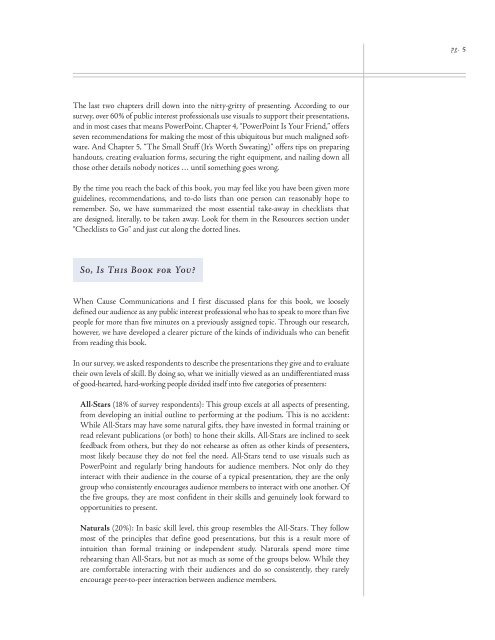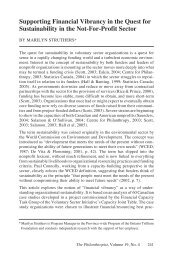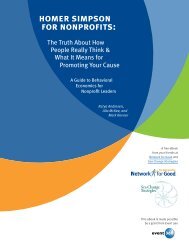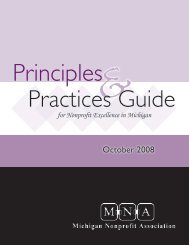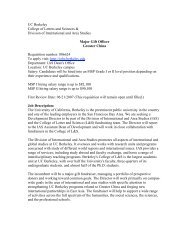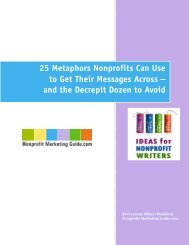Why Bad Presentations Happen to Good Causes - The Goodman ...
Why Bad Presentations Happen to Good Causes - The Goodman ...
Why Bad Presentations Happen to Good Causes - The Goodman ...
Create successful ePaper yourself
Turn your PDF publications into a flip-book with our unique Google optimized e-Paper software.
<strong>The</strong> last two chapters drill down in<strong>to</strong> the nitty-gritty of presenting. According <strong>to</strong> our<br />
survey, over 60% of public interest professionals use visuals <strong>to</strong> support their presentations,<br />
and in most cases that means PowerPoint. Chapter 4, “PowerPoint Is Your Friend,” offers<br />
seven recommendations for making the most of this ubiqui<strong>to</strong>us but much maligned software.<br />
And Chapter 5, “<strong>The</strong> Small Stuff (It’s Worth Sweating)” offers tips on preparing<br />
handouts, creating evaluation forms, securing the right equipment, and nailing down all<br />
those other details nobody notices … until something goes wrong.<br />
By the time you reach the back of this book, you may feel like you have been given more<br />
guidelines, recommendations, and <strong>to</strong>-do lists than one person can reasonably hope <strong>to</strong><br />
remember. So, we have summarized the most essential take-away in checklists that<br />
are designed, literally, <strong>to</strong> be taken away. Look for them in the Resources section under<br />
“Checklists <strong>to</strong> Go” and just cut along the dotted lines.<br />
So, Is This Book for You?<br />
When Cause Communications and I first discussed plans for this book, we loosely<br />
defined our audience as any public interest professional who has <strong>to</strong> speak <strong>to</strong> more than five<br />
people for more than five minutes on a previously assigned <strong>to</strong>pic. Through our research,<br />
however, we have developed a clearer picture of the kinds of individuals who can benefit<br />
from reading this book.<br />
In our survey, we asked respondents <strong>to</strong> describe the presentations they give and <strong>to</strong> evaluate<br />
their own levels of skill. By doing so, what we initially viewed as an undifferentiated mass<br />
of good-hearted, hard-working people divided itself in<strong>to</strong> five categories of presenters:<br />
All-Stars (18% of survey respondents): This group excels at all aspects of presenting,<br />
from developing an initial outline <strong>to</strong> performing at the podium. This is no accident:<br />
While All-Stars may have some natural gifts, they have invested in formal training or<br />
read relevant publications (or both) <strong>to</strong> hone their skills. All-Stars are inclined <strong>to</strong> seek<br />
feedback from others, but they do not rehearse as often as other kinds of presenters,<br />
most likely because they do not feel the need. All-Stars tend <strong>to</strong> use visuals such as<br />
PowerPoint and regularly bring handouts for audience members. Not only do they<br />
interact with their audience in the course of a typical presentation, they are the only<br />
group who consistently encourages audience members <strong>to</strong> interact with one another. Of<br />
the five groups, they are most confident in their skills and genuinely look forward <strong>to</strong><br />
opportunities <strong>to</strong> present.<br />
Naturals (20%): In basic skill level, this group resembles the All-Stars. <strong>The</strong>y follow<br />
most of the principles that define good presentations, but this is a result more of<br />
intuition than formal training or independent study. Naturals spend more time<br />
rehearsing than All-Stars, but not as much as some of the groups below. While they<br />
are comfortable interacting with their audiences and do so consistently, they rarely<br />
encourage peer-<strong>to</strong>-peer interaction between audience members.<br />
pg. 5


